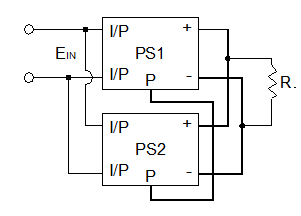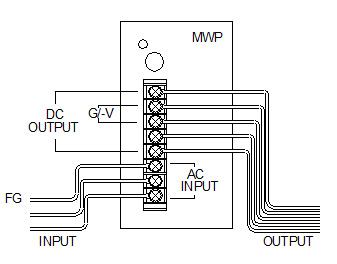Notes and Precautions
NOTE 1
What are the precautions when installing power supplies in the end system?
 The AC power line shall be turned off, and live wire connections shall not be exercised. Turn on AC power after all connections have been properly made to avoid the electrical hazard.
The AC power line shall be turned off, and live wire connections shall not be exercised. Turn on AC power after all connections have been properly made to avoid the electrical hazard.
 The AC power line shall be turned off, and live wire connections shall not be exercised. Turn on AC power after all connections have been properly made to avoid the electrical hazard.
The AC power line shall be turned off, and live wire connections shall not be exercised. Turn on AC power after all connections have been properly made to avoid the electrical hazard.
 Pay attention to the maximum length of mounting screws as specified in the datasheet. If the length exceeds the specifications, the screw may come in contact with internal components and cause electrical failures or even endangerment. Please refer to the installation manual for the appropriate torque settings and wire gauge.
Pay attention to the maximum length of mounting screws as specified in the datasheet. If the length exceeds the specifications, the screw may come in contact with internal components and cause electrical failures or even endangerment. Please refer to the installation manual for the appropriate torque settings and wire gauge.
 When the system is Class I installation, connect the power supply frame ground (FG) with the system frame ground (FG). For more details on installation precautions, please visit Selection Guide-Installation Manual and download the corresponding installation manuals per product types.
When the system is Class I installation, connect the power supply frame ground (FG) with the system frame ground (FG). For more details on installation precautions, please visit Selection Guide-Installation Manual and download the corresponding installation manuals per product types.
NOTE 2
EMC debugging suggestions for end systems with integrated power supplies
MEAN WELL power supplies comply to EMC requirements by themselves, but since power supplies are components, the EMC performance of the end system my not be compliant and needs to be evaluated as a whole. When there are EMC related issues, you may try the suggestions below:
1 Add EMI filter to the power supply input
2 Add grounding choke
3 Add EMI cores to the AC or DC cables
NOTE 3
What is class 2, class II and LPS? What is the difference between class I and class II?
Class I: Equipment where protection against electric shock is achieved by using basic insulation and also providing a means of connecting to the protective earth conductor in the building whereby routing those conductive parts that are otherwise capable of assuming hazardous voltages to earth ground if the basic insulation fails. This means a class I SPS will provide a terminal/pin for earth ground connection.
Class II: Equipment in which protection against electric shock does not rely on basic insulation only, but in which additional safety precautions, such as double insulation or reinforced insulation are provided, there is no reliance on either protective earth or installation conditions. This means a class II SPS does NOT have a terminal/pin for earth ground connection.
The decision on whether to use Class I or Class II power supplies is typically dictated by the end system. If the end system is Class I type, please select Class I power supply, and if the end system is Class II type, please select Class II power supply to avoid performance issues with EMI, hi-pot, etc.
NOTE 4
Protection features of power supplies
When current drawn exceeds the rated output current of the power supply, the protection circuit will be triggered to protect the power supply against overload/overcurrent.
Protections of overload/overcurrent can be divided into several forms:
(1)FOLDBACK CURRENT LIMITING
Output current decreases about 20% of rated current, shown as curve (a) in the figure below.
(2)CONSTANT CURRENT LIMITING
Output current remains at a constant level and within the specified range while the output voltage drops to a lower level, shown as curve (b) in the figure below.
(3)OVER POWER LIMITING
Output power remains constant. As output load increases, the output voltage decreases in proportion, shown as curve (c) in the figure below.
(4)HICCUP CURRENT LIMITING
Output voltage and current keep pulsing ON and OFF repeatedly when protection is activated. The unit automatically recovers when faulty condition is removed.
(5)SHUT OFF
Output voltage and current are cut off when the output load reaches the protection range.
NOTE: Protection mode of some of the products combines with different types of forms mentioned, such as constant current limiting + shut down.
Recover method:
(1)Auto Recovery: PSU recovers automatically after fault condition is removed.
(2)Re-power on: PSU restarts by manual AC re-power on after fault condition is removed.
Note:Please do not operate PSU in overcurrent or short-circuit condition for a long period of time to prevent a shorten lifespan or damaging the PSU.
NOTE 5
What should be taken into considerations when PSUs are in parallel connection?
When power supplies are connected in parallel, we can increase the output current or use them for the redundant (back-up) function. Be sure that the tolerance of output voltage and wiring impedance are very small when connecting in parallel.
Connecting “P” terminals together such as below diagram (“G” terminal also need to be connected together). Input/output should be connected in parallel first and then connect to the AC source/load just as figure 5.1 (some S.P.S. need a minimum load after paralleling).

Figure 5.1: Wiring of S.P.S. with built-in parallel function
Notes on parallel operation:
1. Output voltage tolerance should be less than 0.2Vdc.
2. The power supplies should be paralleled using short and large diameter wiring and then connected to the load.
3. As power system is in full load condition, because of component tolerance, there is possibility that some of the power units being connected in parallel will reach to overcurrent limit therefore trigger over current protection and then overloads other units in the power system. Thus, we suggest the available output power to be de-rated to 90% of the total power.
NOTE 6
Suggestions on Input and Output Wiring
(1) Input and output should be wired in opposite directions to prevent input surge and output ripple noise from interfering with each other.
(2) Output wiring should be short, thick, and meet the output current rating. Also, adding a small capacitor at the load can effectively reduce the noise.
(3) Suitable terminal screws, wires, and tools should be used when connecting to the terminal block.
(4) The FG (Frame Ground) of the AC input is different from the ground (-V / COM) of the DC output. There may be some isolation capacitors between them or it may be shorted together sometimes.

Figure 6.1 Wiring and connection
